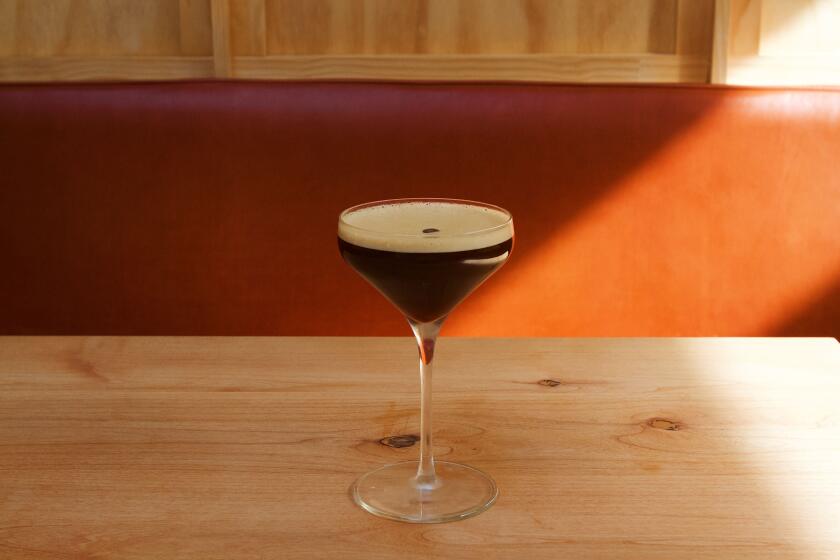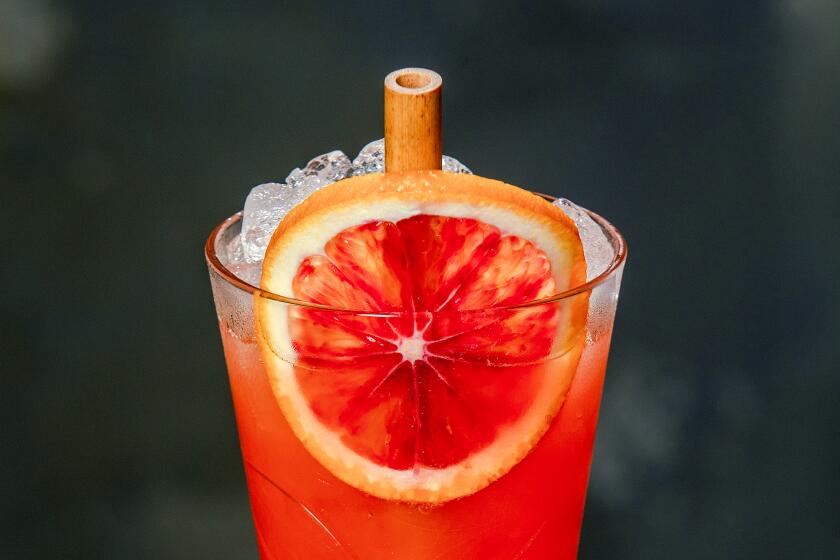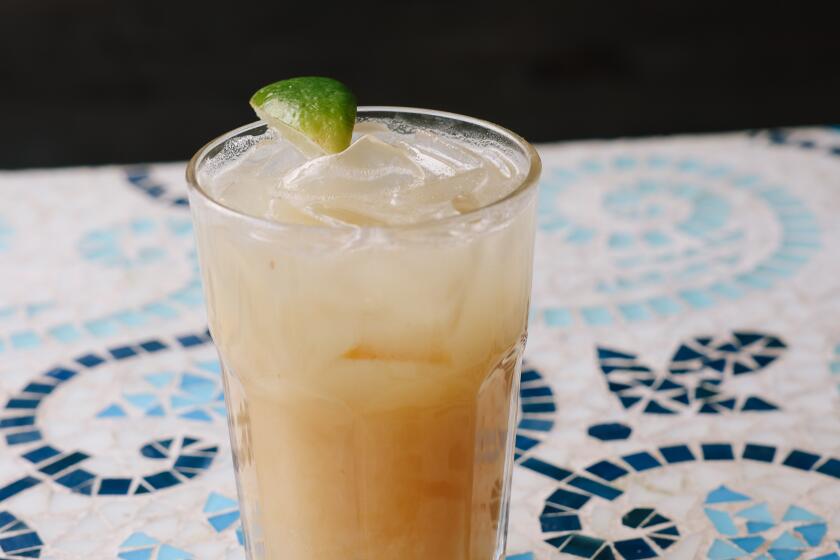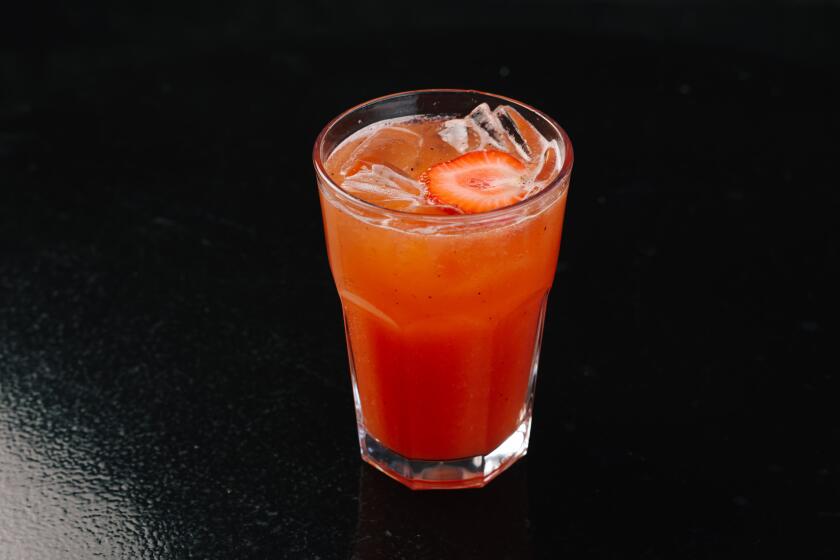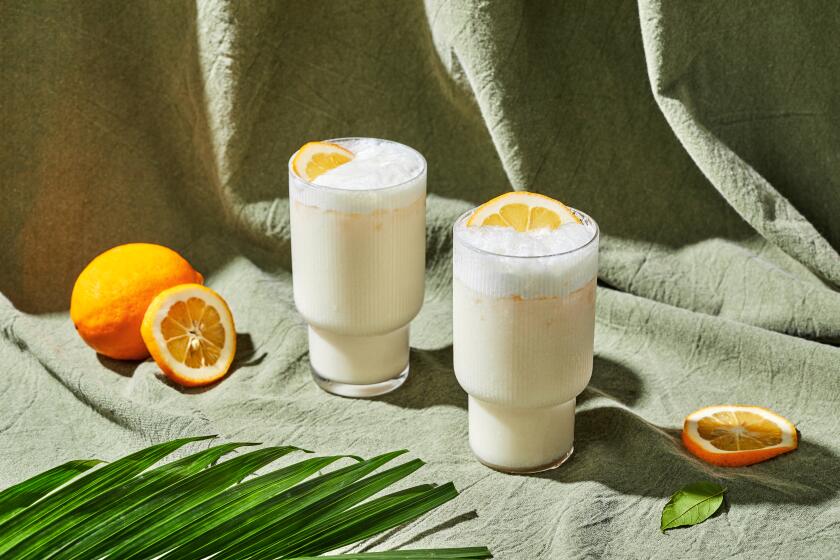Hungry Cat Bloody Mary

- Share via
There’s nothing like a great Bloody Mary. Tangy and spicy, earthy and rich, refreshing yet deeply satisfying, there’s a reason the drink endures as a classic.
It seems simple enough -- just a blend of tomato juice, horseradish, Tabasco, Worcestershire sauce and vodka, garnished with a celery stick -- but it’s actually a tricky drink to make well.
Balance is key, and if you don’t get that just right, you end up with a spice bomb (too much horseradish or Tabasco), a Caesar salad wannabe (too much Worcestershire) or a namby-pamby excuse (too much tomato juice). Froufrou it up with too many vegetables, and you get gazpacho in a glass.
Fortunately for Angelenos, at least a couple of Los Angeles restaurants have started to take Bloody Marys seriously. Very seriously. Last month, the Hungry Cat in Hollywood started offering a Bloody Mary menu at Sunday brunch. The Blvd., the restaurant in the Regent Beverly Wilshire Hotel, has a special Bloody Mary menu as well.
Some of these Marys are so good, they’re raising the bar for the drink. While Hungry Cat starts with a stellar basic drink that’s based on fresh tomatoes, offering well-considered spicy or seafood-centric variations, the Blvd. tends to riff on the drink by changing the spirit. One even uses gin instead of vodka, to marvelous effect. All of them pay close attention to flavor, so the drinks really make sense.
So how to achieve greatness?
“The proportions are key,” says David Lentz, chef-owner of the Hungry Cat. “You can’t throw a bunch of stuff in a glass and expect it to be the same every time. You really have to look at the drink as a recipe and take the time to do it right. I think people underestimate it.”
The Blvd. Manager Ara Aderi, who helped develop the restaurant’s Bloody Mary menu, agrees. “It’s all about finding the perfect balance. Is there enough vodka, enough tomato juice, enough spices for it to really blend well together, but also for you to taste each and every ingredient?”
Then, of course, there’s the quality of those ingredients. Lentz considers the tomato juice to be so important, his restaurant juices its own, year-round.
“Even if you’re not using an heirloom tomato, a plum tomato or a hot house is still better than canned,” he says. “Even if it’s not organic or totally in season, it’s still better than the alternative. It’s a lot fresher. You really get the essence of the tomato.” Lentz uses a Champion juicer, but a blender does fine. It is possible to make an excellent Mary with canned or bottled juice, though -- that’s what most restaurants, including the Blvd., do. Just be sure to use juice that isn’t mucked up with a lot of sugar or salt.
*
A surprising blend
MANY don’t realize that lemon juice is a key ingredient. “Lemon juice is a must with tomato juice,” writes Dale DeGroff, erstwhile bartender at New York’s Rainbow Room, in his book “The Craft of the Cocktail,” “and so the Bloody Mary should always have a couple squeezes of lemon.”
Worcestershire sauce and pepper, usually black but sometimes white, are essential as well, as is salt. Horseradish? Although DeGroff eschews it, Lentz and Aderi both swear by it, and Gary Regan calls for it in the Bloody Mary in his 2003 book “The Joy of Mixology.”
But Lentz also likes to get heat from Fresno chile peppers: small, red, glossy, thumb-size peppers that he grills whole to a black char. The Fresno, he says, is milder and a little more forgiving than the jalapeno. “We use it a lot in cooking,” he says, “so we decided to give it a try and see if it works.” Not only do they contribute another layer of heat, they add a wonderful smokiness.
The other surprise in Hungry Cat’s mix is green pimento-stuffed olives that go straight into the blender with everything else. These add acid, some saltiness and body, says Lentz. And of course there’s the vodka: It pays to use a good one. “Some people say if it’s a mixed drink, don’t waste it,” says Hungry Cat bartender Josh Curtis. “The Bloody Mary made with the premium or good quality vodka is going to be cleaner. You’re going to get closer to the actual mix you’re going for.” He uses Monopolowa, an Austrian potato vodka. The Blvd. gives patrons a choice. Grey Goose, Absolut and Belvedere are the most requested.
But it’s with the spirit that the Blvd. really has its fun. The Highland Mary substitutes whisky for vodka and a sprig of aromatic rosemary for the celery. Use a good blended Scotch, such as Johnny Walker Black Label, for the best results.
Then there’s the terrific gin-based Red Snapper, courtesy of the King Cole Bar in the St. Regis Hotel in New York City. That’s where the Bloody Mary made its U.S. debut in the 1930s. According to Regan, it had been created by Fernand “Pete” Petiot, bartender at Harry’s New York Bar in Paris, circa 1924. Petiot brought it with him when he came to New York to run the King Cole in 1934. He called it a Red Snapper, but it had vodka, not gin. The gin, however, has a surprising affinity with the tomato juice.
The Schnockered and Stingray are two of Hungry Cat’s delicious Mary riffs. The former started with an idea for a garnish -- a trio of pickled vegetables you can nibble while you drink -- and gets a hit of pickled vegetable juice. The Stingray has clam juice and a dash of Old Bay-style spice mix from the Maryland Spice Co. Lentz, who grew up in Baltimore, uses the spice mix liberally in the kitchen. “It brings that whole Chesapeake Bay element to it,” says Lentz. “Tomato, vodka and seafood all go hand and hand -- oyster shooters and that kind of thing. It’s kind of a play on that.” The Maryland Spice Co. mix is a bit saltier and spicier than the widely available Old Bay mix, but either, he says, is fine.
And what if you have a legion of football fans coming by on Sunday? Can you whip up a batch of Bloody Mary mix the night before?
The pros are divided. Lentz says yes; Aderi says you have to mix it the same day or it won’t taste fresh. Either way, get out those measuring cups and spoons, especially if you’re mixing for a crowd. Even when the bartenders at the Blvd. make a batch, they “always measure to make sure everything is perfect,” says Aderi. And don’t stint on the ice. While it may seem counterintuitive, more ice in each glass will keep your Marys from becoming watery.
Of course, you could always use a Bloody Mary mix. Before you turn up your nose, consider one place that does: Thomas Keller’s Bouchon Bistro in Las Vegas. Sommelier Michael Joseph Anthony tasted more than a dozen mixes before settling on Ocean Spray Bloody Mary Mix. A nicely spicy preservatives-free base mix, it has a bit more acidity than tomato juice, says Anthony, who loves its freshness. It’s not available in the retail market, though it can be special ordered from a company called My Brands ([888] 281-6400). Anthony also likes Demitri’s All Natural Bloody Mary Seasoning, which is sold at most Beverages & More and Bristol Farms stores.
Then it’s just a matter of getting the vodka right, mixing ‘em up and pouring onto ice. Did someone say touchdown?
Fill a 9-ounce highball glass with ice. Pour the vodka over the ice. Add the Bloody Mary mix to fill the glass. Dump the contents of the glass into a cocktail shaker. Shake. Pour the chilled mixture back into the glass, sprinkle with a few pinches of salt and serve.
Get our Cooking newsletter.
Your roundup of inspiring recipes and kitchen tricks.
You may occasionally receive promotional content from the Los Angeles Times.










